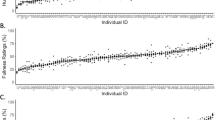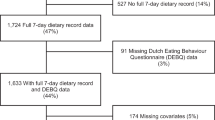Abstract
OBJECTIVES: The present study evaluated the effects of dietary restraint on short-term appetite in response to manipulated palatability.
DESIGN: The effects of palatability on appetite during a lunchtime meal were assessed by contrasting intake of a bland and palatable version of a simple food (within subject). To test how responses to palatability varied with restraint, these meals consumed by women were classified according to restraint (R) and disinhibition (D) scores from the Three-Factor Eating Questionnaire (TFEQ) as high R/high D (HR–HD), high R/low D (HR–LD), low R/high D (LR–HD) and low R/low D (LR–LD).
SUBJECTS: A total of 40 normal-weight women subdivided into four groups based on TFEQ scores.
MEASUREMENTS: The overall intake, appetite and hedonic ratings before, during and after the meal.
RESULTS: All groups ate similar amounts of the bland food, but the LR–HD group ate significantly more of the palatable version than the other groups, whereas HR–LD did not increase intake in response to palatability. Hunger increased on tasting the palatable food in all but the HR–LD group, and this group ended both meals more hungry/less full than the others.
CONCLUSION: Women classified as HR–LD were unresponsive to manipulated palatability, whereas those classified as LR–HD were over-responsive. These findings imply that some individuals are prone to over-respond to palatability and so are at greater risk of developing obesity, whereas others are able to resist the effects of palatability and so successfully self-restrict their food intake. Implications for obesity are discussed.
This is a preview of subscription content, access via your institution
Access options
Subscribe to this journal
Receive 12 print issues and online access
$259.00 per year
only $21.58 per issue
Buy this article
- Purchase on Springer Link
- Instant access to full article PDF
Prices may be subject to local taxes which are calculated during checkout




Similar content being viewed by others
References
Herman CP, Polivy J . A boundary model for the regulation of eating. In: Stunkard AJ, Stellar E (eds.) Eating and its disorders. Raven Press: New York; 1984. pp 141–156.
Ruderman . Dietary restraint: a theoretical and empirical review. Psychol Bull 1986; 99: 247–262.
Herman CP, Polivy J . Restrained eating. In: Stunkard AJ (ed.) Obesity. Saunders: Philadelphia; 1980. pp 208–225.
Van Strein T, Frijters JE, Bergers GPA, Defares PB . Dutch Eating Behaviour Questionnaire for assessment of restrained emotional and external eating behaviour. Int J Eating Disord 1986; 5: 295–315.
Stunkard AJ, Messick S . The three-factor eating questionnaire to measure dietary restraint, disinhibition and hunger. J Psychosom Res 1985; 29: 71–83.
Wardle J, Beales S . Restraint and food intake: an experimental study of eating patterns in the laboratory and in normal life. Behav Res Ther 1987; 25: 179–185.
Dritschel B, Cooper PJ, Charnock D . A problematic counter-regulation experiment: implications for the link between dietary restraint and overeating. Int J Eating Disord 1993; 13: 297–304.
Morgan PJ, Jeffrey DB . Restraint, weight suppression and self-report reliability: how much do you really weigh? Addict Behav 1999; 24: 679–682.
Blanchard FA, Frost RO . Two factors of restraint: concern for dieting and weight fluctuation. Behav Res Ther 1983; 21: 259–267.
Lowe MR . Dietary concern, weight fluctuation and weight status: further explorations of the restraint scale. Behav Res Ther 1984; 22: 243–248.
Heatherton TF, Herman CP, Polivy J, King GA, McGree ST . The (mis)measurement of restraint: an analysis of conceptual and psychometric issues. J Abnorm Psychol 1988; 100: 78–83.
Lowe MR, Maycock B . Restraint, disinhibition, hunger and negative affect eating. Addict Behav 1988; 13: 369–377.
Tuschl RJ . From dietary restraint to binge eating: some theoretical considerations. Appetite 1990; 14: 105–109.
Westenhoefer J . Dietary restraint and disinhibition: is restraint a homogenous construct. Appetite 1991; 16: 45–55.
Westenhoefer J, Broeckmann P, Munch A-K, Pudel V . Cognitive control of eating behaviour and the disinhibition effect. Appetite 1994; 23: 27–41.
Herman CP, Mack D . Restrained and unrestrained eating. J Personality 1975; 43: 647–660.
Spencer JA, Fremouw WJ . Binge eating as a function of restraint and weight classification. J Abnorm Psychol 1979; 88: 262–267.
Wardle J, Steptoe A, Oliver G, Lipsey Z . Stress, dietary restraint and food intake. J Psychosom Res 2000; 48: 195–202.
Ruderman AJ . Dysphoric mood and overeating: a taste of restraint theory's disinhibition hypothesis. J Abnorm Psychol 1985; 94: 78–85.
Polivy J, Herman CP . The effects of alcohol on eating behavior: disinhibition or sedation? Addict Behav 1976; 1: 121–125.
Yeomans MR . Taste, palatability and the control of appetite. Proc Nutr Soc 1998; 57: 609–615.
Maffeis C . Aetiology of overweight and obesity in children and adolescents. Eur J Pediatr 2000; 159: S35–S44.
McCrory MA, Suen VMM, Roberts SB . Biobehavioral influences on energy intake and adult weight gain. J Nutr 2002; 132: 3830S–3834S.
Walker ARP, Walker BF, Adam F . Nutrition, diet, physical activity, smoking and longevity: from primitive hunter–gatherer to present passive consumer—how far can we go? Nutrition 2003; 19: 169–173.
Bellisle F, Lucas F, Amrani R, Le Magnen J . Deprivation, palatability and the micro-structure of meals in human subjects. Appetite 1984; 5: 85–94.
Bobroff EM, Kissileff H . Effects of changes in palatability on food intake and the cumulative food intake curve of man. Appetite 1986; 7: 85–96.
Yeomans MR . Palatability and the microstructure of eating in humans: the appetiser effect. Appetite 1996; 27: 119–133.
Yeomans MR, Lee MD, Gray RW, French SJ . Effects of test-meal palatability on compensatory eating following disguised fat and carbohydrate preloads. Int J Obes Relat Metab Disord 2001; 25: 1215–1224.
Yeomans MR, Gray RW, Mitchell CJ, True S . Independent effects of palatability and within-meal pauses on intake and subjective appetite in human volunteers. Appetite 1997; 29: 61–76.
Tepper BJ . Dietary restraint and responsiveness to sensory-based food cues as measured by cephalic phase salivation and sensory specific satiety. Physiol Behav 1992; 52: 305–311.
Teff KL, Engelman K . Palatability and dietary restraint: effect on cephalic phase insulin release in women. Physiol Behav 1996; 60: 567–573.
Rogers PJ, Hill AJ . Breakdown of dietary restraint following mere exposure to food stimuli: interrelationships between restraint, hunger, salivation, and food intake. Addict Behav 1989; 14: 387–397.
De Castro JM, Bellisle F, Dalix A-M, Pearcey SM . Palatability and intake relationships in free-living humans: characterization and independence of influence in North Americans. Physiol Behav 2000; 70: 343–350.
Yeomans MR . Rating changes over the course of meals: what do they tell us about motivation to eat? Neurosci Biobehav Rev 2000; 24: 249–259.
Yeomans MR, Lartamo S, Procter EL, Lee MD, Gray RW . The actual, but not labelled, fat content of a soup preload alters short-term appetite in healthy men. Physiol Behav 2001; 73: 533–540.
Gray RW, French SJ, Robinson TM, Yeomans MR . Dissociation of the effects of preload volume and energy content on subjective appetite and food intake. Physiol Behav 2002; 76: 57–64.
Kissileff HR, Kilngsberg G, Van Italie TB . Universal eating monitor for continuous recording of solid or liquid consumption in man. Am J Physiol 1980; 238: R14–R22.
Haynes CL . The interactive effects of dietary restraint and disinhibition on ingestive behaviour. University of Sussex: Brighton; 2001. 411 pp.
Yanovski SZ, Leet M, Yanovski JA, Flood M, Gold PW, Kissileff HR, Walsh BT . Food selection and intake of obese women with binge-eating disorder. Am J Clin Nutr 1992; 56: 975–980.
Peterson CB, Mitchell JE, Engbloom S, Nugent S, Mussell MP, Crow SJ, Miller JP . Binge eating disorder with and without a history of purging symptoms. Int J Eating Disord 1998; 24: 251–257.
Howard CE, Porzelius LK . The role of dieting in binge eating disorder: etiology and treatment implications. Clin Psychol Rev 1999; 19: 35–44.
Knight LJ, Boland FJ . Restrained eating: an experimental disentanglement of the disinhibiting variables of perceived calories and food type. J Abnorm Psychol 1989; 98: 412–420.
Stirling LJ, Yeomans MR . Effects of exposure to a forbidden food on eating in restrained, unrestrained women. Int J Eating Dis, (in press).
Steere J, Cooper PJ . The effects on eating of dietary restraint, anxiety, hunger. Int J Eating Disord 1993; 13: 211–219.
Acknowledgements
This research was partly funded by an undergraduate bursary from the Nuffield Foundation to Heather Tovey.
Author information
Authors and Affiliations
Corresponding author
Rights and permissions
About this article
Cite this article
Yeomans, M., Tovey, H., Tinley, E. et al. Effects of manipulated palatability on appetite depend on restraint and disinhibition scores from the Three-Factor Eating Questionnaire. Int J Obes 28, 144–151 (2004). https://doi.org/10.1038/sj.ijo.0802483
Received:
Revised:
Accepted:
Published:
Issue Date:
DOI: https://doi.org/10.1038/sj.ijo.0802483
Keywords
This article is cited by
-
Understanding Individual Differences in Acquired Flavour Liking in Humans
Chemosensory Perception (2010)
-
Interaction between Disinhibition and restraint: Implications for body weight and eating disturbance
Eating and Weight Disorders - Studies on Anorexia, Bulimia and Obesity (2010)
-
Food Intake and Reward Mechanisms in Patients with Schizophrenia: Implications for Metabolic Disturbances and Treatment with Second-Generation Antipsychotic Agents
Neuropsychopharmacology (2006)



